IA Launches its Extended Reality (XR) Wing // A Discussion with David Bourke and Guy Messick

Zoom meetings are a dime a dozen these days, but some progressive companies and firms are thinking much further ahead. If the world of work is moving toward a more complex blend of in-person and remote work, how can we go beyond the Zoom meeting and tap into a better way of collaborating virtually?
When you begin to look at this question, there’s a good chance the topic of virtual reality will come to mind.

When we found out that IA Interior Architects officially launched its IAXR Extended Reality practice, we jumped at the chance to talk to David Bourke, Co-President & CEO of IA. Also joining our conversation was Guy Messick, principal and Director of Design Intelligence at IA.
IA has long been a leader in VR, and on its website, it explains why it was so keen on integrating VR into its practices early on:
“Any successful design process relies on all stakeholders sharing a common understanding of project goals. In the past, these goals were tested and evaluated by taking a 3D design and distilling it down to 2D snapshots such as floor plans, renderings, and elevations. Once the design process was complete, these were compiled and handed off to be constructed as a 3D reality. But translation leaves room for miscommunication. VR, often referred to as an empathy engine, not only equalizes the way we view a design but allows all stakeholders to simultaneously share the same experience. This increases efficiency because the design can remain three dimensional from the schematic phase through project completion. As a result, the design review evolves from a spectator sport to a first-person participatory experience and exploration.”
The launch of IAXR is only the most recent development in IA’s long history of leadership in XR. Under Bourke’s direction, the firm has been piloting, co-developing and interacting with these technologies for several years. In our interview with Bourke and Messick, Bourke talked about how IA got to its position as a leader in extended reality.

As at many other organizations around the world, the pandemic fueled IA to think differently, and to act.
“VR has been in use in our industry for several years as a technology, and as a firm we’ve certainly embraced it and have wanted to be at the forefront of it. The pandemic acted as a catalyst that really pushed us to move forward in our use and investment in this technology. The first part of the pandemic, we were in a bit of a panic, in finding ourselves all locked down in March. We were trying to figure out, ‘what’s next?’, and it started with a small kernel of an idea, to build on this great experience base in XR that we already had in place.”
“We thought it was important for us to put the same amount of time and effort into virtual spaces as we do the physical space, and move further into the world of Extended Reality (XR). Lo and behold, we became partners with many development platforms – because we found we needed to provide an option that hasn’t been available anywhere else.”
The new IAXR Extended Reality practice was developed to “create and deliver a highly branded and customized XR experience. This practice will provide our clients with an opportunity to augment their physical space, bring together distributed teams, and support the user experience.” For those unaware, Extended Reality (XR) is the umbrella term for environments that combine the real and virtual, including Virtual Reality (VR), Augmented Reality (AR), and Mixed Reality (MR).
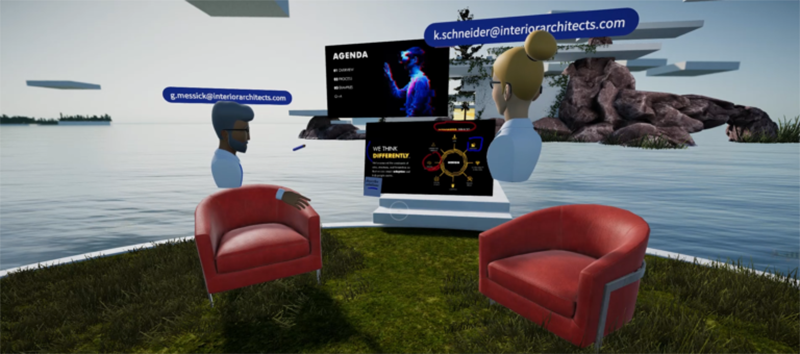
The World of Extended Reality
On its website, IA has a great blog post giving a general introduction to the nuances of XR. In the article, Kat Schneider, a Digital Design Application Specialist with IA’s Digital Intelligence group, lays out the differences among the various forms of XR. The nuts and bolts are as follows:
>Virtual Reality (VR) allows users to be transported to a virtual or simulated experience; their actual physical surroundings are completely excluded.
>Augmented Reality (AR) technology superimposes digital elements on top of the user’s physical environment. This can be done through wearable headsets such as the HoloLens 2 or experienced from a tablet device.
>Mixed Reality (MR) blends the digital world with the physical environment. While similar to AR, with MR digital objects are not superimposed but integrated with the user’s physical surroundings.
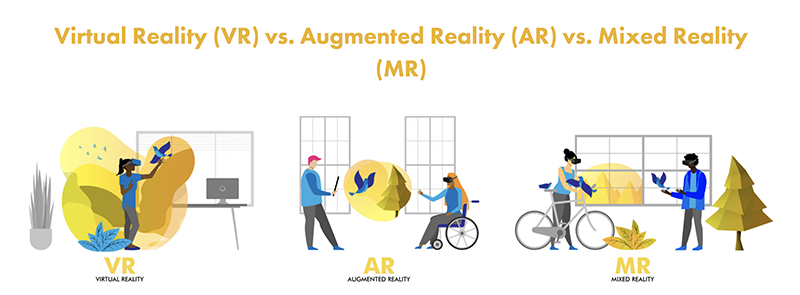
When the pandemic hit, IA recognized an opportunity.
“We were in a great position to immediately start answering the question, ‘How can we meet in a more satisfying way than by Zoom or Skype?’” said Messick. “And how can the ways we’re answering this question for our own purposes, also then apply to a client? Instead of thinking about meetings – we’re thinking about casual collisions, and how virtual environments can have that, too. The idea that you can be at home with a laptop and a headset, and can still virtually move around your physical office. Or, instead of using a simple Zoom platform to present to a group, being able to present in a true auditorium through the use of virtual. In March, we really began to tap into this experience base we have, and in May started to partner with clients in working on how to extend the camaraderie and social space of the virtual world.”
“Earlier we had delivered several projects working in the virtual space, and they weren’t perfect, but they had transformative effects on the end result,” Messick continued. “When you design in virtual reality, you’re seeing a space before it’s being built, which is incredibly valuable. Clients began asking about it because we have street cred in the VR world, and it’s had very positive, fortuitous results.”
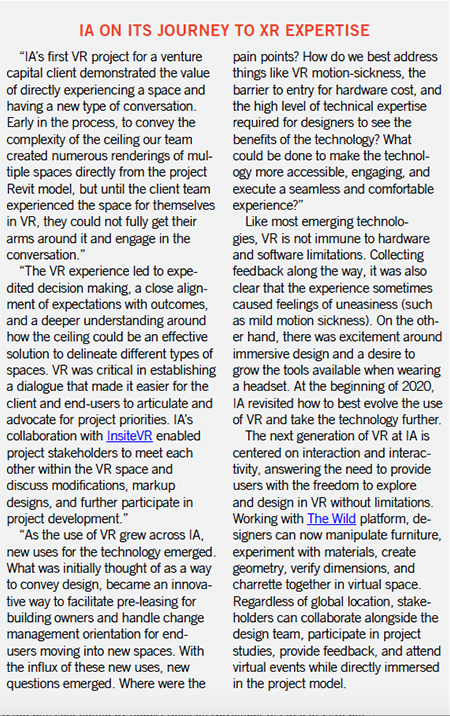 Now, IA is focused on bringing all the pieces of extended reality together, including the ethereal-like elements of Mixed Reality. In her article, Ms. Schneider writes:
Now, IA is focused on bringing all the pieces of extended reality together, including the ethereal-like elements of Mixed Reality. In her article, Ms. Schneider writes:
“Designers must continue to experiment with how augmented and mixed reality can enhance our process. These technologies give us the ability to simulate a blended experience, combining the precision of the physical environment with the introduction of virtual objects for exploration. Collaboration around certain aspects of the construction process relies on the capacity to contextualize the designed infrastructure by viewing digital content through wearable technology like the HoloLens 2 or via tablets or smartphones.
“As we continue to spend more time physically apart from one another, the need to connect remains, and the concept of virtual space becomes an invaluable tool for those requiring an alternative to in-person collaboration. The concept of virtual space allows users to participate in an interactive environment where nearly everything can be changed at a moment’s notice – size, color, shape, etc. – and even allows for 3D models to be imported, enabling users to experiment with different materials, and furniture. What’s more, this technology has been imbued with collaborative tools like group whiteboards, video posting, swatches, note taking, and document editing. In effect, virtual space has the ability to not only replace in-person collaboration, but also provide users with more flexibility and immediately-visible results than in-person collaboration ever could.
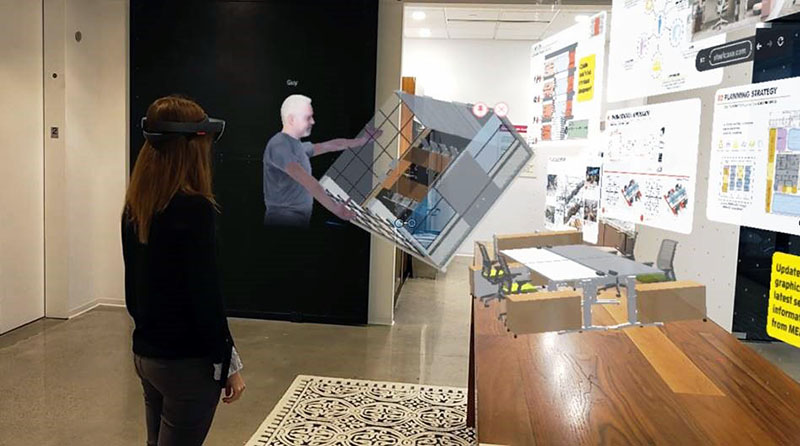
“The extension of our reality through the use of immersive technology and virtual space is affecting large scale changes to the infrastructure of meetings. Small things, like the use of human shaped avatars and realistic gesturing, provide a sense of familiarity and presence unlike anything we are used to in video conferencing. For us, the idea of establishing virtual destinations creates the opportunity to eliminate some of the barriers existing in the physical world. To work more effectively in this increasingly digital era, we are excited about the possibilities of crafting unique environments that accommodate exactly what we must focus on to achieve design and client goals.”
A New Way of Thinking About Design
We asked Bourke and Messick about the specifics of working with clients in XR, and they each shared valuable insights.
“Regardless of what happens post-pandemic, extended reality will be a part of how we do business in the future,” Bourke said. “We now have the opportunity to create different and totally new environments in the workplace that haven’t been there before [those in the virtual world], and that could be an incredible game changer.”
“We’re often using our XR capabilities to help clients on a more departmental level, rather than company-wide. The emphasis is not on the entire organization being ‘progressive’, but more about how do we get our workforce to be more productive and feel more engaged, and which teams and departments within our organization could really benefit from using this technology.”
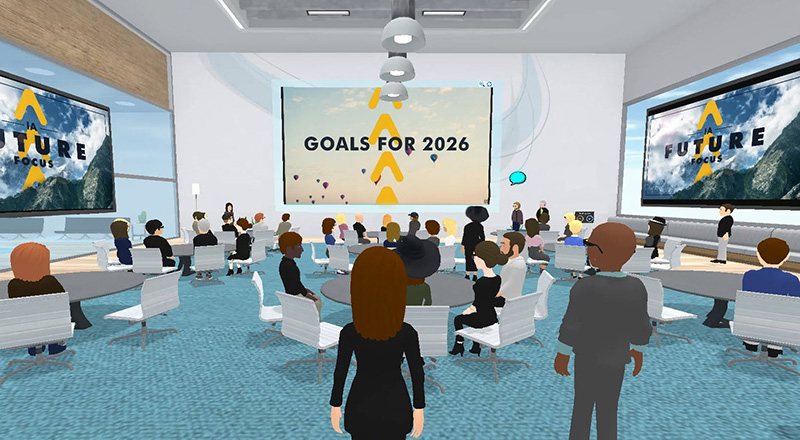
IA is pushing our view of XR technology beyond that of a handy “tool” and more toward a totally new way of designing.
“By working with this technology, we no longer have the same rules, and so we also don’t have the same needs as we used to,” Messick said. “It’s not just a new technology platform – it’s a completely new way of thinking about the design of spaces. We’re expanding the notion of what design services really are. It’s not just the environments, but the platforms enabling them that are changing. And things are happening weekly; in six months to a year, there will be drastic changes.”
“A significant part of our effort in partnering with XR platform developers is in creating more ease of use,” Messick continued. “These platforms need to be easy to use, because XR can come across as overwhelming and even a little spooky to some users. That’s why we thought it was really important to partner in developing them.”
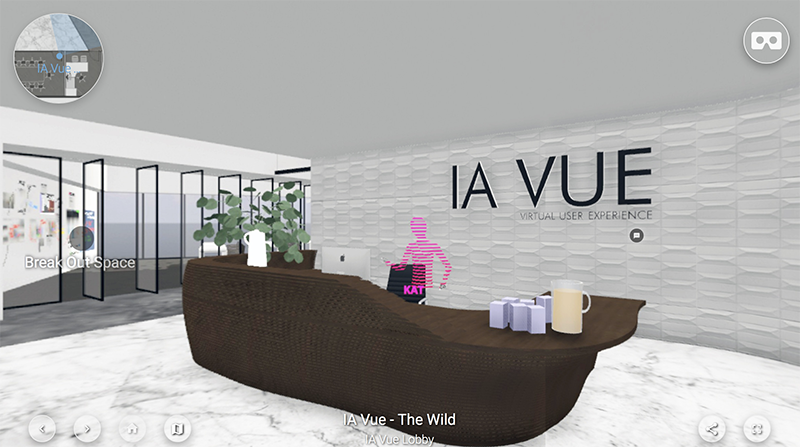
IA has set a path for itself as a – the – leader of the design community in Extended Reality, and this goal was set very intentionally.
“What’s really important about all of this is that it is all about design,” said Bourke. “In the past, it’s been easy to pass off the expertise in some of these tools to the gaming community, because that community has always been an early adopter of it. But as designers, we have the ability to use these tools as well to create exceptional experiences – and to become leaders in XR just as much as the gaming community has become.”
We can’t know for sure the changes to come in the next year, but XR will most certainly play a bigger role in the way we work. IA made, and continues to make a great bet on investing in it.




